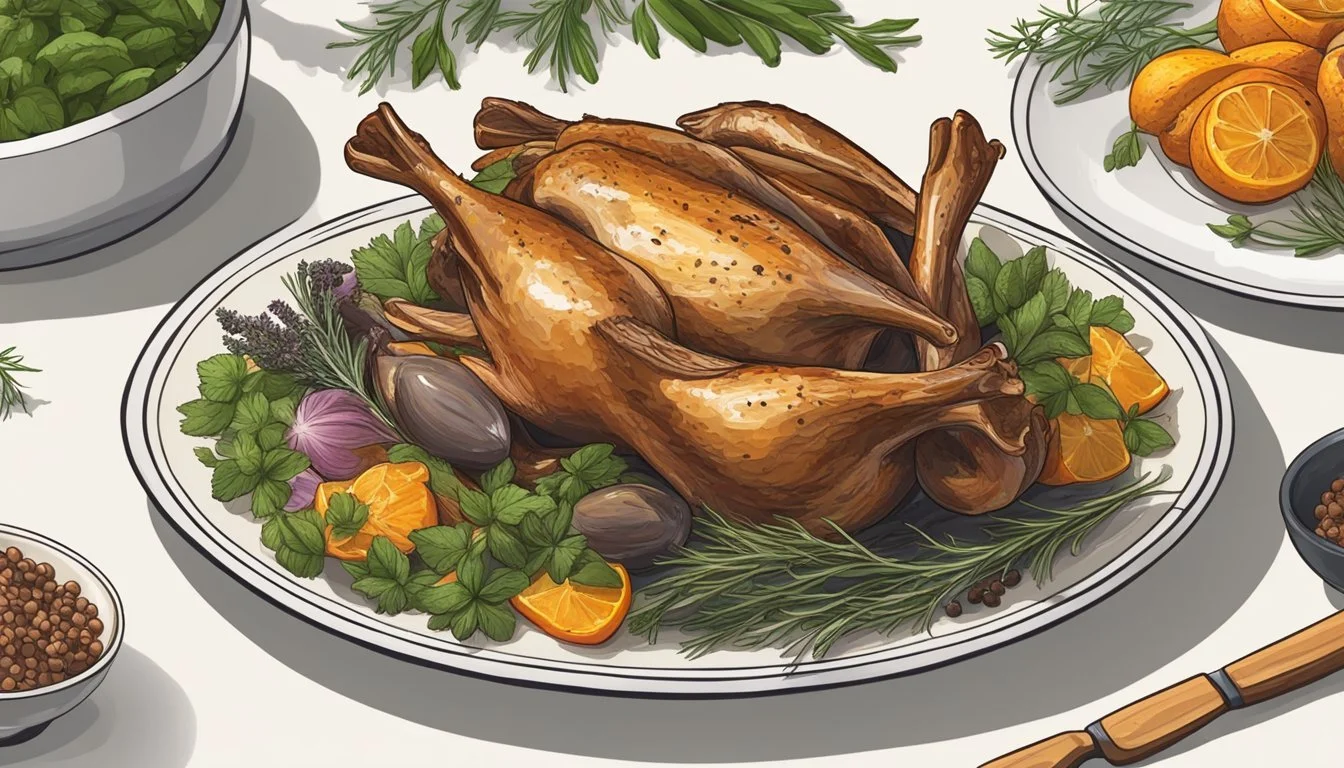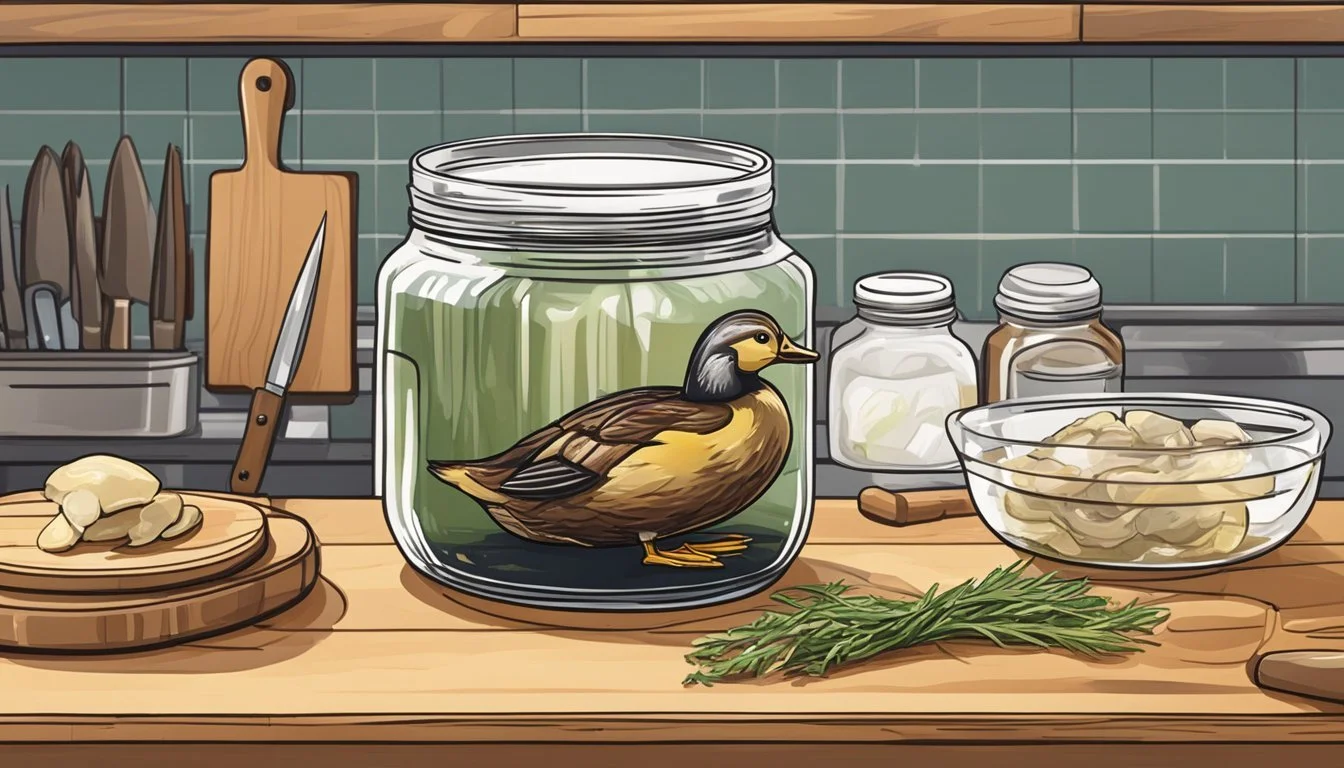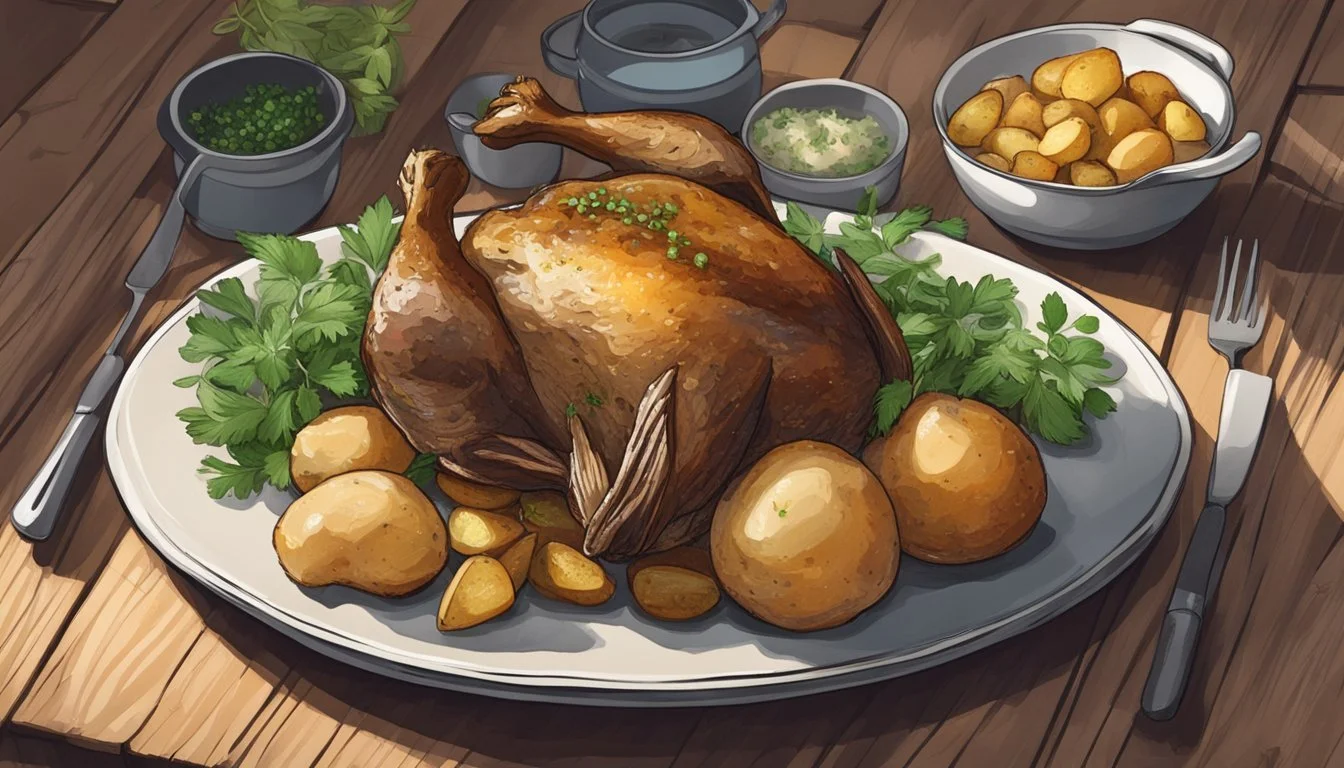How to Eat Duck Confit
A Guide to Enjoying This Classic Dish
Duck confit (What wine goes well with duck?) is a classic dish deeply rooted in French culinary tradition. The term 'confit' comes from the French word 'confire,' which means to preserve, and this is exactly the essence of the dish—a method of preservation that dates back to a time before refrigeration. To create duck confit, the duck legs are slow-cooked in their own fat until they are exquisitely tender. This ancient technique not only imparts a rich flavor but also enables the duck to be stored for longer periods, making it a staple in traditional French cuisine.
Savoring duck confit involves appreciating its delicate balance of flavors and textures. Once cooked, the duck's skin becomes remarkably crisp, offering a delightful contrast to the succulent and flavorful meat beneath. It’s important to serve the dish at a temperature that highlights its tender texture to ensure the full experience of its deep and savory taste.
Duck confit is often accompanied by a variety of side dishes that complement its rich and savory profile. It can be easily integrated into a myriad of recipes, from being the centerpiece alongside simple accompaniments like roasted potatoes and seasonal vegetables to featuring in sophisticated preparations such as cassoulet—a hearty, slow-cooked bean stew. The versatile and distinctive nature of duck confit makes it a cherished dish, celebrated for its complex layers of flavor and longstanding history in French cuisine.
Ingredients and Preparation
Crafting duck confit involves a meticulous process that ensures the meat is seasoned, cured, and cooked to perfection, resulting in a tender and flavorful dish.
Selecting the Right Duck and Fat
One should select quality duck legs and duck fat for a successful duck confit. The fat is critical as it acts as a medium for slow-cooking the duck legs and preserving them. Freshness is essential; seeking out freshly slaughtered, plump duck legs can make a noticeable difference in flavor. For the fat, pure rendered duck fat is preferred, though some opt for a blend with other fats for cost-effectiveness without significant compromises on taste or texture.
Curing the Duck Legs
Curing the duck legs is a vital step that involves rubbing them with a mixture of salt, aromatics like crushed garlic, and herbs, especially fresh thyme, along with peppercorns, bay leaves, and cloves. A generous application of the curing mix infuses the legs with flavors and aids in moisture extraction. The mixture typically includes:
Coarse salt (critical for curing)
Garlic (minced or sliced)
Black pepper (crushed or whole peppercorns)
Thyme (fresh is preferable for its vibrant flavor)
Additional herbs and spices (like bay leaves and cloves)
After applying the curing mixture, the duck legs are refrigerated for 12 to 24 hours, allowing the salt and herbs to penetrate deeply and begin the preservation process.
The Confit Cooking Process
After curing, the duck legs are rinsed to remove the excess salt and then patted dry. They are then placed in a single layer in an ovenproof dish and completely submerged in duck fat. Cooking in a low oven at temperatures around 225°F (105°C) ensures that the duck legs are slowly and gently cooked until tender. The process can take a few hours, but the slow-cooking method is crucial for achieving the characteristic tenderness of duck confit. Once cooked, the legs can be preserved in the fat and kept in a cool place, allowing them to develop deeper flavors over time.
Cooking Techniques
Duck confit is a luxurious dish where duck legs are rendered tender through slow-cooking while submerged in fat. Here are two methods one can employ to prepare this French culinary classic, ensuring the meat is cooked perfectly while preserving its flavors.
Traditional Oven Method
The traditional technique involves slow-cooking duck legs in an oven set to a low temperature. One starts by gently heating duck fat in a pan until it is liquid. Once the duck legs are seasoned with salt and perhaps some aromatics like garlic, thyme, or bay leaves, they are placed in a deep baking dish. The warm duck fat is then poured over the legs until they are fully submerged, ensuring that the moisture is locked in. Covered with foil or a lid, the dish goes into an oven typically heated to around 225°F (107°C) and is cooked for a few hours until the meat is tender and easily separates from the bone.
Preheat oven to 225°F (107°C)
Submerge duck legs fully in melted duck fat
Cook for several hours until meat is falling off the bone
Alternative Sous Vide Technique
Sous vide duck confit offers a modern twist on the classical method by using precise temperature control in a water bath. The duck legs are first seasoned, optionally with aromatics, then placed in a vacuum-sealed bag with some duck fat before being submerged into the water bath. This method uses a sous vide cooker to maintain a consistent low-temperature environment typically between 135°F (57°C) and 155°F (68°C). The long and slow-cooking process, which can last for 24 to 36 hours, makes the duck extraordinarily tender while infusing it with the flavors of the fat and aromatics.
Season and seal duck legs with duck fat in a vacuum bag
Submerge in sous vide water bath set to 135°F - 155°F (57°C - 68°C)
Cook for 24 to 36 hours for maximum tenderness
Post-Cooking Handling
After the duck confit has been cooked, proper handling is crucial to preserve its quality and flavor. This involves cooling and storing the confit safely, as well as reheating it in a way that maintains its crispy skin and succulent texture.
Cooling and Storing
Once the duck confit is cooked, it should be allowed to cool to room temperature. For longer preservation, the duck can be transferred to jars along with the rendered duck fat. The fat acts as a sealant that protects the duck from air exposure, which helps in preserving its flavor and freshness. These jars should be refrigerated, ensuring that the duck confit remains in good condition for future use—often several weeks if stored properly.
Cooling Tip: Place the duck on a rack to cool evenly and to avoid sogginess.
Storing Step-by-Step:
Transfer the duck confit into clean jars.
Pour the rendered duck fat over the confit, ensuring it is fully submerged.
Seal the jars and refrigerate.
Reheating and Serving Suggestions
Reheating duck confit properly is key to achieving a crispy exterior while keeping the meat tender. The confit should be placed skin-side down in a pan and reheated gently. The meat can also be warmed in an oven set to a moderate temperature, or placed under a broiler for a short period to crisp the skin. When using a broiler, closely monitor the confit as the intense heat can quickly go from crisping to burning.
Oven Method:
Preheat the oven
Place duck confit on a rack in a baking dish
Heat until skin is crispy and meat is warmed through
Pan Method:
Heat pan over medium heat
Place duck confit skin-side down
Cook until skin is crispy
Broiler Method:
Preheat the broiler
Position the confit skin-side up on a broiler-safe pan
Broil until the skin is the desired crispiness, being careful to avoid burning
Pairings and Accompaniments
The art of enjoying Duck Confit (Confit de Canard) lies in complementing its rich flavor with the right side dishes. Whether one leans towards traditional French cuisine or contemporary pairings, the selection of accompaniments can enhance the dining experience.
Traditional French Sides
Duck Confit traditionally pairs with hearty, rustic French sides. Key among these is Cassoulet, a slow-cooked casserole containing beans, sausages, and sometimes duck. Another classic accompaniment is Pommes de Terre à la Sarladaise - potatoes sautéed in duck fat with garlic and parsley, providing a crispy texture contrast.
Salad: Simple green salads, dressed with a light vinaigrette, cut through the richness of the duck.
Lentils: Green Puy lentils, cooked with shallots and a touch of garlic, offer a peppery bite.
Beans: White beans are a subtle, creamy counterpart to the confit's robustness.
Contemporary Pairings
Contemporary sides can also complement Duck Confit by balancing its flavor profile with inventive twists.
Greens: Sautéed kale or spinach, seasoned with a bit of garlic, provide a nutritious and flavorful mix.
Pasta: A subtle pasta dish, perhaps with a light sauce and wilted greens, can serve as a delicate bed for the confit.
Cabbage and Chili: A stir-fry of cabbage spiced with mild chili adds a refreshing crunch and a hint of heat.
Modern fusion also introduces Duck Confit Tacos, where the shredded duck is paired with a slaw or seasoned beans, enveloped in a soft tortilla. This showcases the versatility of confit in various culinary contexts.
Preservation and Make-Ahead Techniques
Duck confit is a culinary technique where the meat is preserved by being salted and cooked slowly in its own fat. This centuries-old method allows for advanced preparation and long-term storage, making duck confit an ideal make-ahead dish.
The duck is first seasoned with salt, perhaps along with herbs and spices, to cure the meat.
It is then slowly cooked at a low temperature submerged in its own rendered fat.
Once cooked, the duck is cooled and can be stored, fully submerged in the fat, in airtight containers.
Make-Ahead Advantage:
By preparing duck confit in advance, flavors deepen over time, which enhances the overall taste.
The aging process in the fat can last for weeks, even months, under proper refrigeration, without a loss in quality.
Storage Solutions:
For home preservation, glass jars or plastic containers with tight seals are recommended.
Confit should always be covered with a layer of fat to ensure an oxygen-free environment, deterring spoilage.
Guidelines for Aging:
Aging duck confit for at least one day before consumption is typical to allow the flavors to meld.
The meat can continue aging within the fat, often improving in taste and texture for up to six months when refrigerated.
By adhering to these preservation and make-ahead techniques, cooks ensure the duck confit remains moist, flavorful, and ready to be enjoyed at a moment's notice.
Health and Dietary Considerations
When consuming duck confit, one must consider the nutritional content and the method of preparation, as these factors significantly contribute to its health impacts. Duck confit involves slow-cooking duck in its own fat, and while this method imparts a rich flavor, it also adds a substantial amount of fat to the dish.
Caloric Content: Duck confit is high in calories due to the fattening process. Each serving typically contains a significant amount of saturated fat.
Fat Selection:
Lard: Traditional confit is often prepared with lard or duck fat, which can be high in saturated fats.
Olive oil: For a healthier version, some replace lard with olive oil, which offers monounsaturated fats known to be better for heart health.
Nutritional Profile:
Protein: Duck meat is an excellent source of protein.
Vitamins and Minerals: It provides B vitamins and minerals such as iron and zinc.
To reduce fat content, one might consider:
Draining excess fat: After cooking, allow the duck to rest on a wire rack so excess fat can drip off.
Portion size: Serve smaller quantities to limit fat intake.
Those with dietary restrictions, such as a low-fat or heart-healthy diet, should:
Be wary of the high-fat content.
Consult a nutrition professional if considering incorporating duck confit into their meal plan.
Individuals looking for a balance can enjoy duck confit occasionally as part of a varied and balanced diet.
Culinary Variations
Duck confit is traditionally a French preparation hailing from Gascony, but it has been adapted worldwide, often taking on unique flavors and presentation methods that reflect local culinary traditions.
Fusion Recipes
In fusion cuisine, duck confit serves as a rich and savory counterpoint to a variety of flavors and textures. One innovative take involves incorporating duck confit into tacos. This approach melds the succulent, slow-cooked duck with the casual, spicy profile of street-style tacos, often complemented by a tangy slaw or relish to balance the rich duck fat. Another fusion variation pairs duck confit with lentil ragout, introducing hearty legumes for a wholesome and satisfying meal.
Global Influences in Duck Confit
As duck confit travels beyond its French roots, it absorbs global influences while retaining its essential character. In some regions, chefs serve duck confit atop a bed of roast potatoes, embracing the duck fat's ability to crisp the potatoes to a perfect golden brown. This method honors the French side dish principle, where the potatoes benefit from the seasoned fat used in confit. Across various cultures, duck confit is being used as a luxurious add-on, magnifying the depth of familiar dishes.
Conclusion
The culinary delight of duck confit reflects traditional French cuisine's dedication to both flavor and technique. It leaves diners with a memorable experience of meltingly tender meat beneath a crisped, golden exterior. When served, the confit carries an air of elegance, a testament to the meticulous slow-cooking process it undergoes.
One can appreciate duck confit in numerous preparations, whether it's the centerpiece of the dish or incorporated into more complex recipes. It offers a versatile profile that pairs well with a variety of sides and ingredients, from simple greens to hearty root vegetables.
To fully savor duck confit, it’s advised to warm it gently until the skin crisps to its renowned texture. Whether a culinary novice or a seasoned chef, one can be confident in preparing a dish featuring duck confit, assured by its inherent richness and depth of flavor. In essence, it stands as a pinnacle of culinary craftsmanship, rewarding the palate of those who favor robust and intricately layered dishes.
For enthusiasts eager to explore the intricacies of French gastronomy, duck confit is a commendable start. Its presence on a plate signifies not just a meal but an invitation to indulge in a slice of culinary heritage that has stood the test of time.









